The time is now.
As an industry, we have been making headway in greening the built environment for the last twenty years but that is not enough, and not quick enough. We need to achieve zero carbon emissions as soon as possible and act with a sense of urgency.
Ed Mazria, Founder and CEO of Architecture 2030, is leading the charge in charging all of us to take action now. Last month at the Carbon Smart Building Day Conference held in San Francisco, Mr. Mazria gave the opening keynote – To Net Zero Carbon and Beyond: Framing the Challenge, to a gathering of building industry professionals. He established a framework for phasing out building carbon emissions and defined the commitments that we must make to achieve a Net Zero Carbon environment.
Some videos from the plenary sessions and breakouts are already available on the website of the Carbon Smart Building Day Conference’s Videos tab but the rest will come shortly. Presentation slide decks from most speakers are also available and can be found in the Slides tab. The following article is a partial transcription and summary of Mr. Mazria’s presentation which is about 23 minutes long and very well worth your viewing time.
That’s the Goal: Zero Emissions.
That’s the Challenge: Cities and Urban Developments.
What are the actions that must be taken, that we all need to take to achieve those goals?
First, the bad news is that we’re running out of time so we need to act really fast.
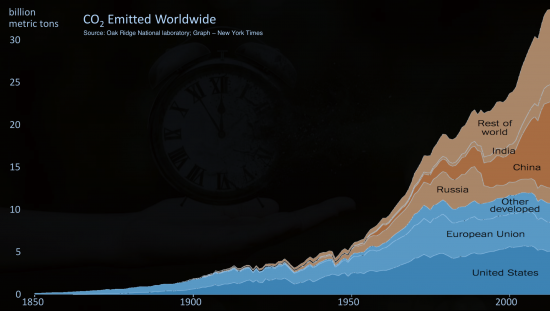
CO2 is a worldwide phenomenon and every country is involved, so we need to act globally.
CO2 is growing exponentially, it is not leveled out and it is not going down.
The good news is that we know where the emissions are coming from. The urban environment is responsible for 75% of all human-produced global greenhouse gas emissions. In the cities, most of the emissions are coming from buildings in the cities. This is where we need to act.
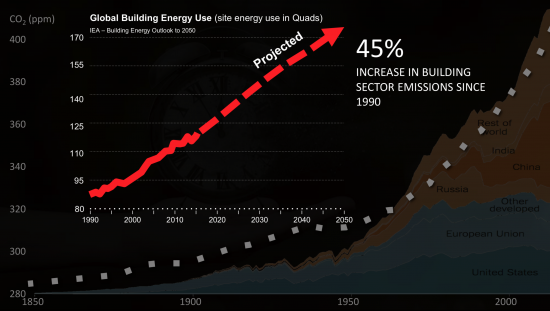
If we look at global building energy use: there is a 45% increase in building sector emissions since 1990. If keep doing what we are doing, then emissions are going to go up dramatically. The reason that that is a problem is because 74% of the energy going into the buildings come from fossil fuels globally.

In December of 2015, the world came together to set some targets:
- Not going over 1.5 degrees Celsius.
- CO2 emissions has to peak between now and 2020.
- CO2 emissions has to decline to zero emissions by 2050.
By 2060, world urban population is expected to increase by about 2.67 billion people, so that is where the building is happening. Every week, 1.5 million people are being added to cities worldwide. By 2060, global building floor area will increase by 230 billion square meters, or double the current worldwide building stock.
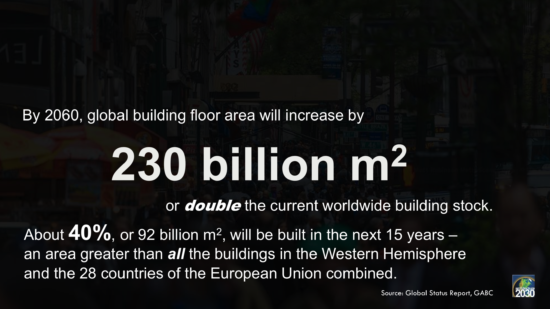
So the date that we’ve been talking about, 2030, is now out the window because it’s not fast enough.
We need to think about 2020, and we need to think about now and 2020.
Every effort we make has to make an impact and it has to be scalable. From building type to building type, from city to country, and from country to country.
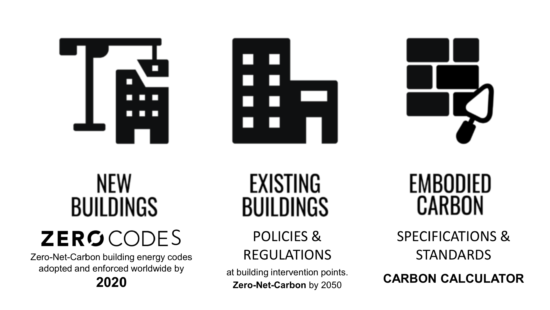
When we look at buildings, we look at three categories.
Building Operations
In San Francisco County, energy consumption is flat, and California is now generally flat. Every progressive state’s energy consumption is flat, (New York, Pennsylvania, and Illinois), but it’s not going down. We need to bend the curve down. Canada, is flat. EU- 28, is also flat. The developed world is pumping out emissions and we’re not reducing energy consumption. The problem is that consumption is going up because of the building.
How do we get a handle on this?
The global north has building energy codes but not all codes are good. The global south mostly has building codes. Most of the bldg. stock is in the global north but global south building is starting to pick up without building codes. The global north needs to set an example for the global south and has to work on getting energy codes in the south.

New Buildings
We need zero carbon codes and get it across the globe.
The good news:
- China has been convinced to implement nearly zero building codes plus renewables to get all the way to net zero carbon. We will work though the China Accord signatories to move this out.
- EU has directed countries to be nearly zero building codes plus renewables to get all the way to net zero carbon by 2020.
| BIG Announcement | A few weeks ago, we launched ZERO Code, a US and international building energy standard for new building construction. |
ZERO Code is essentially designing energy efficient building with onsite and offsite renewables. How do you meet the ZERO Code? Via either the prescriptive or performance path which are both built into the national building standards and for which software has already been developed.
ZERO code provides a predictable and reliable for market for renewable energy year after year.
| BIG Announcement | ZERO Code has been launched for California. |
| BIG Announcement | AIA has announced its support for the ZERO Code. |
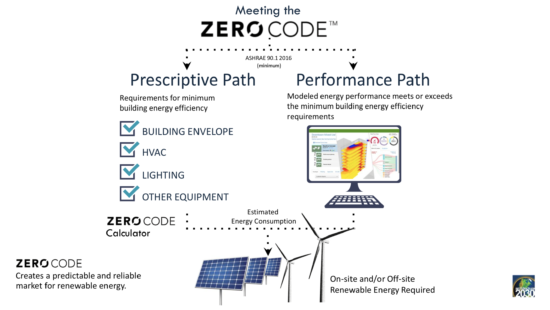
Existing Buildings
We need policies, regulations, and mandates for existing buildings. Efficiency upgrades are not happening fast enough.
Voluntary action is not enough.
So we need policies and regulations, and mandates for existing buildings. We need to scale the mandates worldwide.
How do we develop policies for existing buildings?
In Seattle, 2.8% of buildings are responsible for 45% of GHG emissions in Seattle and the other small buildings are responsible for the rest of the emissions. There are similar numbers for other cities including New York City, Los Angeles, San Francisco, Boston, Minneapolis, Phoenix, Vancouver, and Chicago.
We can develop big building policies such as requiring energy upgrades by 2030 and zero emissions by 2050. We can develop small building policies such as requiring energy upgrades at building intervention points such as change of use, point of sale etc.
Embodied Carbon
Why is it important?
In year one, almost all of emissions is from embodied carbon (48%) and 52% comes from building operations. We need to get a handle on embodied carbon and we need to have performance and prescriptive paths.
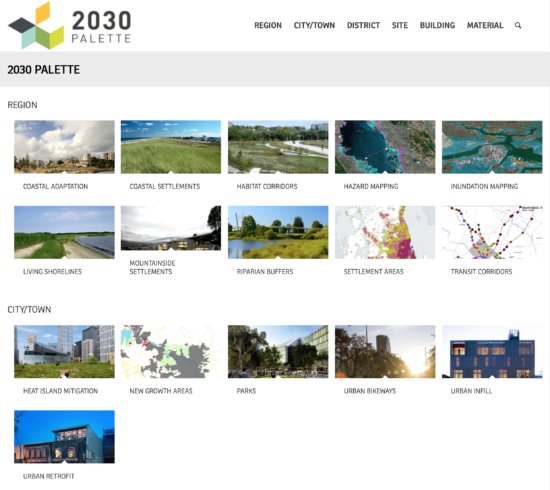
| BIG Announcement | Today we launched 2030 Palette, a database of carbon smart materials and a resource for the design of zero net carbon, adaptable and resilient built environments worldwide. |
| BIG Announcement | EC3 by Skanska is doing the performance path by 2019. |
| BIG Announcement | It’s time to act now. |


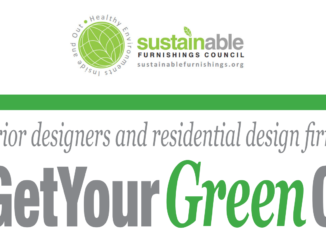


Be the first to comment